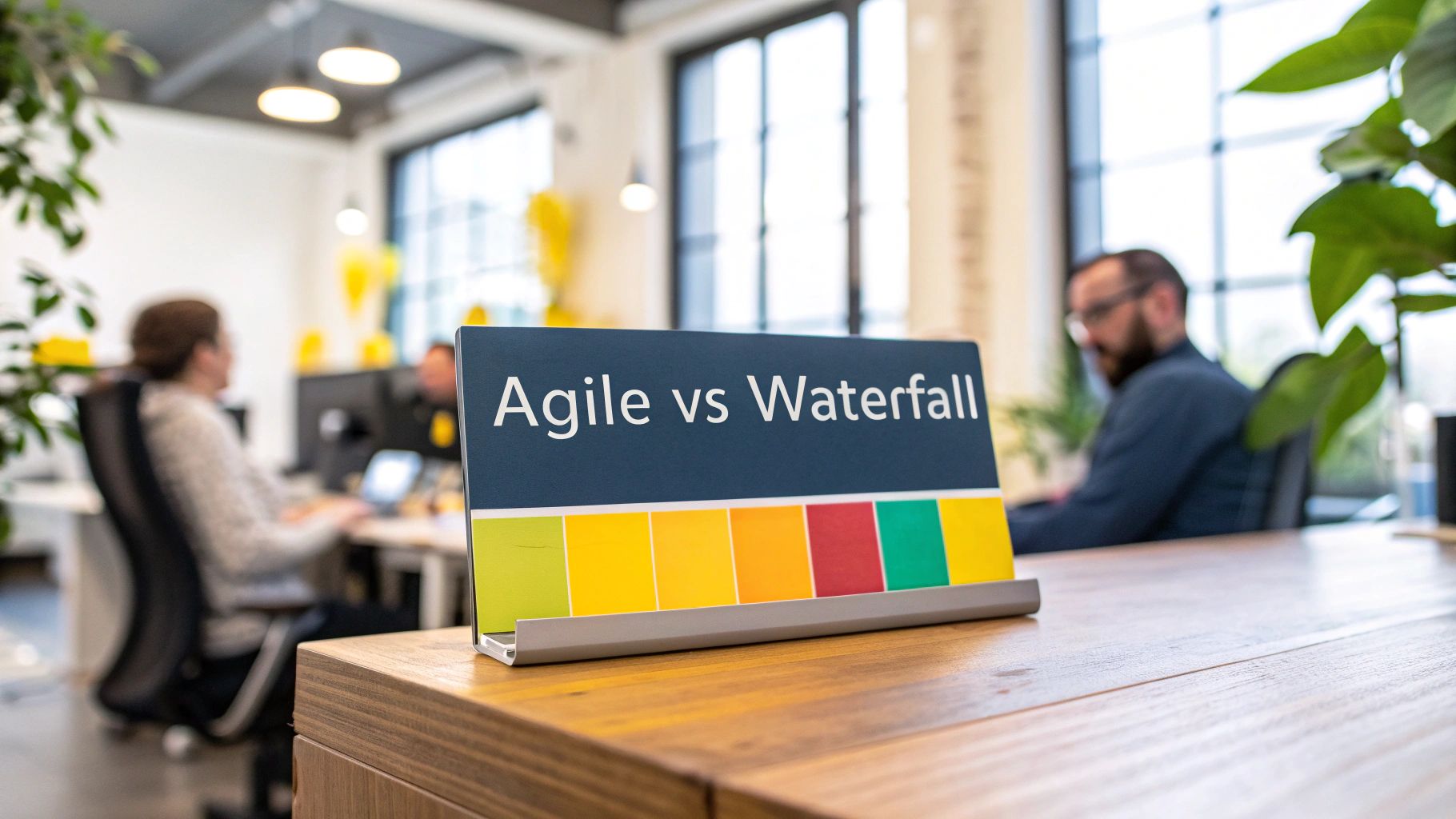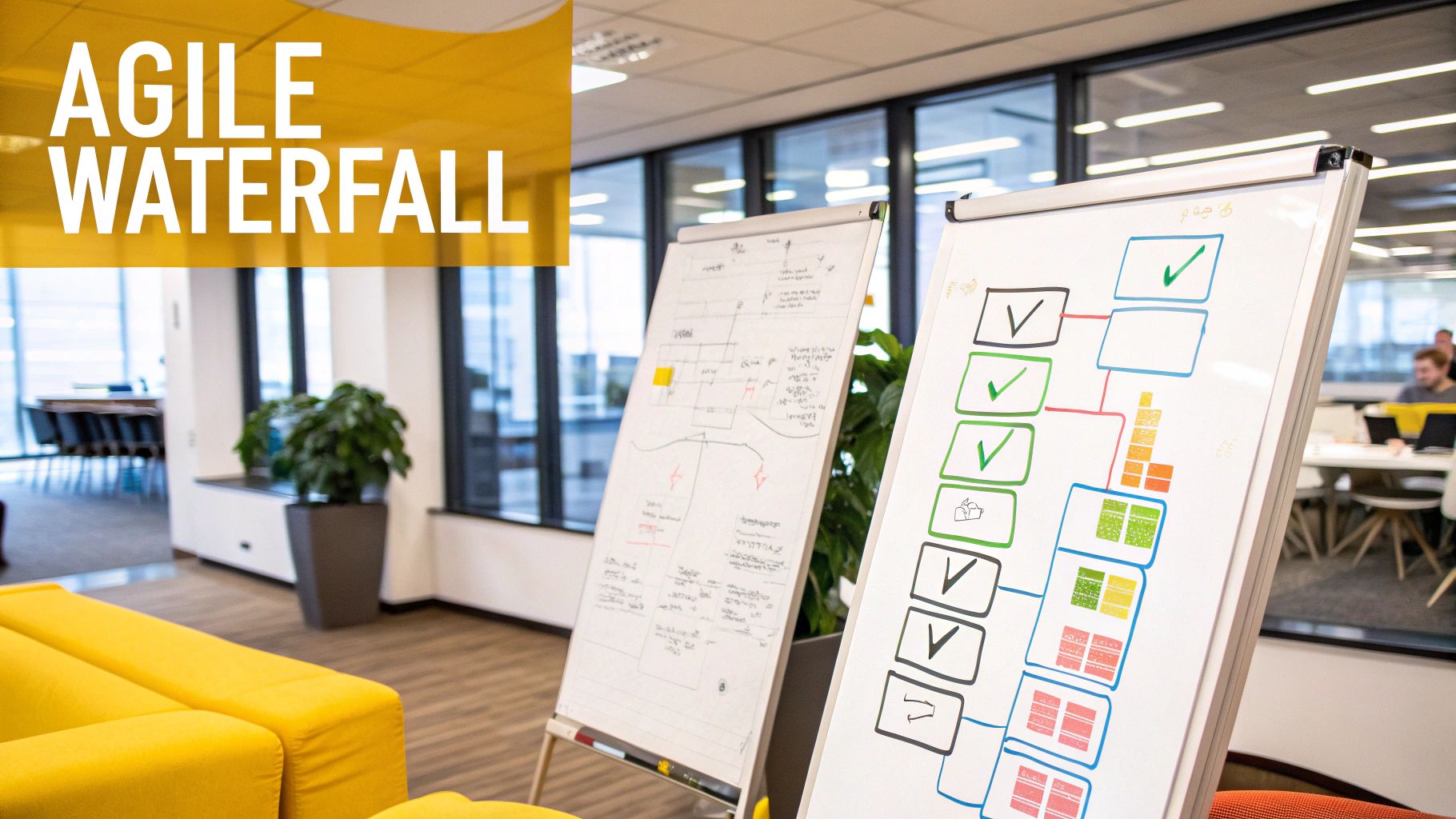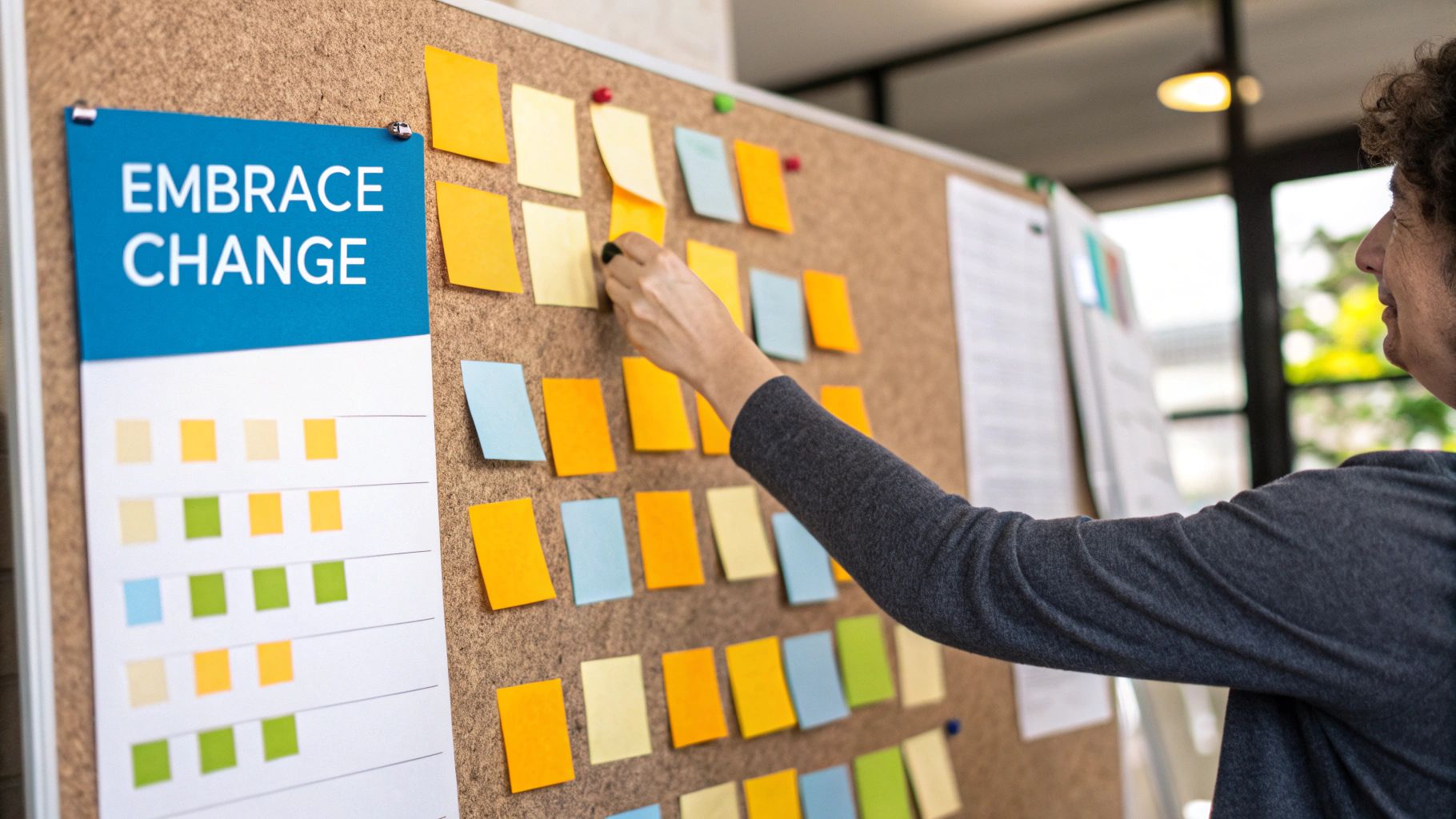Agile vs Waterfall Methodology Choosing the Right Fit

The whole agile vs waterfall methodology debate really boils down to one core idea. Agile is built for change and uncertainty, using a flexible, iterative process. In contrast, Waterfall is a straight line—a linear, sequential model that works best when you know exactly what you need to build from day one. The path you choose will fundamentally shape how your team plans, executes, and adapts from kickoff to launch.
Understanding the Two Methodologies
Picking the right project management methodology isn't just a technical choice; it's one of the most important decisions your team will make. It sets the tone for everything—your timeline, budget, how you handle surprises, and ultimately, the quality of what you deliver. Getting it wrong can lead to blown deadlines, bloated budgets, and a final product that just doesn't hit the mark with users.
To really get why this matters so much, it helps to understand a critical perspective on traditional project planning, which is the bedrock of the Waterfall approach. This context shines a light on exactly why Agile gained so much traction as an alternative.

A High-Level Comparison
Before we get into the nitty-gritty, let's start with a simple analogy. Think of the Waterfall method like building a house. You can't start framing the walls until the foundation is poured and cured. Each step must be fully completed before the next one can begin. It’s a rigid, predictable process.
Agile, on the other hand, is more like a chef preparing a multi-course tasting menu. They create one dish, get feedback, and then use that input to refine the next. Different components are worked on in cycles, allowing for creativity and adjustments based on what people are actually enjoying.
This core difference impacts everything from how you talk to stakeholders to how you handle risk. Waterfall tries to lock everything down early, while Agile assumes you'll learn as you go, building the plan and embracing change along the way.
The real tension between Agile and Waterfall isn't just about process; it's a clash of philosophies. Waterfall is designed to control and minimize change, whereas Agile is built to embrace it.
To make these differences crystal clear, the table below offers a quick side-by-side look at how each methodology handles key project attributes.
Core Differences Between Agile and Waterfall
| Attribute | Agile | Waterfall |
|---|---|---|
| Structure | Iterative and cyclical | Linear and sequential |
| Flexibility | High adaptability to change | Low; changes are costly and difficult |
| Client Involvement | Continuous and collaborative | Mostly at the beginning and end |
| Planning | Adaptive and happens continuously | Detailed and done upfront |
| Delivery | Small, frequent releases of working software | Single, final delivery at the end |
| Risk Management | Risks are addressed in each cycle | Risks are identified upfront and managed via the plan |
| Best For | Projects with evolving or unclear requirements | Projects with fixed, well-defined requirements |
This table serves as a great starting point. As we dig deeper, you'll see how these fundamental distinctions play out in the real world.
A Deep Dive into the Waterfall Methodology
Think of the Waterfall methodology as the traditional, tried-and-true way to manage a project. It’s a completely linear approach, and its name gives you the perfect mental picture: progress cascades down from one distinct phase to the next, just like a waterfall. You have to 100% complete each stage before you can even think about starting the next one. This creates a highly structured, predictable path from A to Z.
This model didn't just appear out of thin air; its logic comes from industries like manufacturing and construction. You can't start framing the 10th floor of a skyscraper before the first nine are built and stable. Waterfall applies that same rigid, step-by-step thinking to software development.

The Unchanging Phases of a Waterfall Project
Every Waterfall project moves through the same sequence of non-overlapping stages. This strict separation is what really sets it apart from more modern, flexible models.
Requirements Gathering and Analysis: This first step is everything. It's where project managers and analysts sit down with stakeholders to document every single requirement in exhaustive detail. The final output is a massive specification document that serves as the project's bible.
System Design: Once the requirements are set in stone, system architects and senior developers map out the entire structure. This phase covers hardware needs, software architecture, data models—the whole nine yards. Not a single line of code is written until this design is fully signed off.
Implementation (Coding): Now, the developers finally get to work. They take the design documents and start building the software, usually breaking the work into smaller units that are eventually pieced together to form the complete system.
Testing and Verification: With coding done, the project is handed over to the Quality Assurance (QA) team. Their job is to hammer the system with tests, comparing its performance against the original requirements document to hunt down any bugs or flaws.
Deployment: After the bugs are squashed and the system is fully verified, it’s time for launch. The product is deployed to the customer's environment or released to the market.
Maintenance: The project isn't over yet. This final phase covers all the ongoing support and updates needed to fix any issues that pop up after the product is live.
This sequential process is both Waterfall's biggest advantage and its most glaring weakness in the agile vs waterfall methodology debate.
Strengths and Weaknesses in Practice
The main draw of Waterfall is its predictability. When all requirements are defined at the very beginning, you can estimate timelines, budgets, and resource allocation with a pretty high degree of accuracy. That makes it a solid choice for projects where the scope is fixed and everyone knows exactly what needs to be built from day one.
Plus, the heavy emphasis on documentation creates a very clear paper trail. This can be a lifesaver in large organizations, for projects that have to meet strict regulatory compliance, or in situations where team members might come and go over the project's long lifecycle.
Waterfall’s rigid structure provides clarity and control, but at the cost of adaptability. A mistake in the requirements phase can be catastrophic, as it may not be discovered until the testing phase, months or even years later.
But that same rigidity is also its Achilles' heel in today's fast-moving world. There’s almost no room to make changes once a phase is locked. If market needs shift or a customer has a brilliant new idea halfway through, trying to pivot is incredibly difficult and costly. The lack of early feedback means teams can spend months or years building something that, in the end, doesn't quite hit the mark with users—a risk that Agile was specifically created to solve.
Unpacking the Agile Methodology and Its Guiding Principles
If Waterfall is a detailed, sequential roadmap, think of Agile as a dynamic GPS. It came about because developers realized that rigid, traditional models just couldn't keep up with the fast-changing, often unpredictable world of software development. Instead of tackling a project in one long, linear push, Agile breaks the work down into small, digestible cycles.
This entire approach is guided by the values laid out in the Agile Manifesto. The core idea is to prioritize individuals and interactions over rigid processes and to value customer collaboration more than hammering out every detail in a contract. The result is a system that can react and pivot based on real-time feedback, not one that’s stuck following a plan that might already be obsolete.

How Iterative Development Actually Works
The real magic of Agile is in its iterative rhythm. Projects move forward in a series of short cycles, usually called sprints, that typically last between one and four weeks. Each sprint is like a mini-project in itself, complete with planning, design, coding, and testing. At the end, the team has a tangible, working piece of the product to show for their efforts.
This process is fueled by a few key components:
- User Stories: Forget dense, hundred-page requirement documents. Agile uses simple, concise descriptions of a feature from the user’s point of view. They quickly answer the "who, what, and why" without getting lost in technical jargon.
- Continuous Feedback Loops: At the close of each sprint, the team shows what they've built to stakeholders. This constant back-and-forth is crucial. It lets the team make adjustments on the fly and ensures the final product is what users actually want.
- Adaptability: Change isn't the enemy in Agile; it's expected. If a new market opportunity pops up or user testing reveals a major flaw, the team can simply adjust course in the next sprint.
This flexibility is why Agile has taken over the industry. As of 2021, an estimated 86% of software development teams were using Agile, a huge leap from just 37% in 2020.
Popular Agile Frameworks: Scrum vs. Kanban
Agile is more of a philosophy than a strict set of rules, and a few frameworks have emerged to help teams put it into practice. The two most common are Scrum and Kanban, and they each bring a different flavor to the process.
Scrum is a highly structured framework built around those fixed-length sprints we talked about. It has clearly defined roles, like a Scrum Master to keep the process running smoothly and a Product Owner to manage the project backlog. Everything is time-boxed, from Daily Standups to Sprint Retrospectives, which gives the team a predictable cadence. If you want to get into the nitty-gritty, we have a guide that explores what the Scrum methodology is all about: https://getnerdify.com/blog/what-is-scrum-methodology.
Kanban, on the other hand, is all about flow. It’s a more flexible system that focuses on visualizing the team’s workflow and limiting how much work is in progress at any one time. Teams use a Kanban board to move tasks from "To Do" to "Done," which helps optimize the continuous delivery of work without being constrained by fixed sprints.
The Good and the Bad of Going Agile
The biggest win with Agile is its incredible adaptability. Teams can respond to new information without derailing the entire project, which almost always leads to happier customers and a faster time-to-market. By releasing working software in small, frequent increments, companies can start delivering value and seeing a return on their investment much sooner.
But Agile isn’t a silver bullet. That same flexibility can sometimes open the door to scope creep, where the project’s goals keep expanding without any clear finish line. It also requires a very disciplined and engaged team. Self-organization and constant communication are non-negotiable. As you can learn from a comprehensive guide to the agile product development process, without strong leadership and a committed team, the freedom of Agile can quickly descend into chaos.
A Nuanced Comparison of Agile and Waterfall
To get beyond the surface-level summaries, a real agile vs waterfall methodology comparison means digging into how each one handles the things that make or break a project. This isn't just a simple story of speed versus planning. We're talking about two fundamentally different philosophies for managing change, working with customers, and dealing with risk. Understanding these practical trade-offs is the only way to make the right choice for your team.

Adaptability to Change
How a methodology handles the unexpected is probably its most defining trait. Let's be honest, projects rarely stick to the script. Market conditions shift, competitors launch new features, and user feedback can send you in a completely new direction.
Waterfall's Approach: With Waterfall, change is seen as a problem—a deviation from the master plan. Once the requirements phase is locked, introducing any change means kicking off a formal, and often slow, change control process. This rigidity keeps the project on its original path, but it also makes reacting to new information painfully slow and expensive.
Agile's Approach: Agile doesn't just tolerate change; it expects and even welcomes it. The entire point of iterative sprints is to build, get feedback, and adjust priorities on the fly. This lets teams constantly refine the product based on what they learn, ensuring the final result is something people actually want.
Scope Definition and Management
The way you define and control a project's scope has a direct line to your timeline and budget. This is where the two models really part ways.
In a Waterfall project, the scope is spelled out in exhaustive detail and frozen solid during the initial requirements phase. The goal is to eliminate scope creep by creating a bulletproof, unchangeable plan. This works beautifully when you know exactly what the final product should be from day one.
Agile, on the other hand, treats scope as a moving target. You start with a high-level vision, but the specific features are prioritized and fleshed out over time. This flexibility is powerful, but it's a double-edged sword. Without strong product ownership, it can lead to a project that never seems to end.
Agile embraces scope evolution as a way to discover value, while Waterfall enforces scope rigidity as a way to control outcomes. The right choice depends on whether your project's greatest risk is building the wrong thing or failing to stick to the budget.
Customer Involvement and Feedback
When and how often you talk to your customers is critical for building a product they'll actually use. The two methodologies put the customer in very different seats throughout the project.
Waterfall typically brings the customer in for a deep dive at the very beginning (for requirements) and then again at the very end (for final approval). In between, there's often a long quiet period. This creates a huge risk that what the development team builds isn't what the customer truly needed.
In contrast, Agile demands constant customer collaboration. It's common for stakeholders to be part of sprint planning, reviews, and demos. This continuous feedback loop cuts out the guesswork and ensures the product evolves right alongside user expectations. It’s a huge reason for Agile’s success.
Risk Management Strategy
Every project has risks, whether they're technical roadblocks or budget blowouts. How you spot and handle those risks is a core part of any project management approach.
Waterfall: This method tries to manage risk with intensive upfront planning. The idea is to think of every possible thing that could go wrong and create a plan to avoid it. The danger here is that a surprise risk that pops up late in the game can be catastrophic.
Agile: Agile manages risk by iterating. By building and testing small chunks of the product in short cycles, teams can find and fix problems early and often. This approach dramatically reduces the impact of any single issue.
No matter which methodology you lean toward, integrating solid SDLC best practices is essential for keeping risks in check.
Head-to-Head Comparison Table
To really see these differences side-by-side, here’s a quick breakdown of how Agile and Waterfall stack up on key project aspects.
| Project Criterion | Agile Approach | Waterfall Approach |
|---|---|---|
| Adaptability | High. Built to welcome and incorporate change. | Low. Change is costly and disruptive. |
| Scope | Flexible and emergent, refined over time. | Fixed and defined upfront. |
| Customer Role | Continuous collaborator and feedback provider. | Primarily involved at the start and finish. |
| Risk Mitigation | Addressed iteratively in small, manageable cycles. | Handled via extensive upfront analysis and planning. |
| Team Structure | Cross-functional, self-organizing teams. | Hierarchical, with specialized roles in distinct phases. |
| Communication | Constant, informal, and face-to-face is preferred. | Formal, through documentation and status reports. |
Studies have shown that these differences have a real-world impact. Projects run with Agile methods consistently outperform Waterfall projects in both timely delivery and product quality. I’ve seen it firsthand—companies that switch often report a dramatic drop in critical bugs and a major reduction in developer burnout. I remember one organization that struggled for three years with Waterfall, constantly missing deadlines. After finally moving to an Agile framework, they hit their targets and saw their critical issues plummet.
Choosing Your Methodology: Real-World Scenarios
The theory behind Agile and Waterfall is one thing, but the real test comes when you have to apply it to your own project. Deciding which way to go in the agile vs waterfall methodology debate isn't about picking the "better" one in a vacuum; it’s about choosing the right tool for the job you have right now.
Looking at concrete examples is the best way to move this decision from an abstract concept to a practical choice based on your project's DNA.
When to Go with Waterfall
The Waterfall model truly shines in environments where certainty and predictability are king. It’s the natural choice for projects where the requirements are set in stone from the beginning, are unlikely to change, and demand extensive documentation before a single line of code is written.
Here are a few scenarios where Waterfall is almost always the smarter path:
- Regulated Industries: Imagine you're developing software for a medical device or a core banking system. These projects live and die by strict compliance and safety standards. Every single requirement has to be documented, designed, tested, and verified before you can move to the next phase. Waterfall’s linear, gated approach provides that essential paper trail and control.
- Construction and Manufacturing: You can't start building a bridge until the architectural designs are completely finished and approved. The same goes for setting up a factory assembly line. The rigid, sequential nature of Waterfall perfectly mirrors the physical dependencies inherent in these kinds of projects.
- Small, Well-Defined Projects: If the task is to build a simple, straightforward application with a fixed scope and a crystal-clear end goal, Waterfall is incredibly efficient. Why bother with iterative feedback loops when you already know exactly what the final product needs to be?
The real strength of Waterfall is its power to manage projects where the cost of a mistake is astronomically high and the requirements are absolutely non-negotiable. Its structure is built to minimize risk in highly predictable situations.
When Agile is the Answer
Agile, on the other hand, was built for the exact opposite environment—one full of uncertainty, innovation, and the need to move fast. If you expect your project's requirements to evolve as you learn more from your users or the market, then Agile's flexibility is your greatest asset.
Think about these real-world situations where Agile is the clear winner:
- New Product Development: Launching a brand-new mobile app or a SaaS platform is often a journey of discovery. You're working off assumptions about what people want. Agile lets you build a minimum viable product (MVP), get it into users' hands, and then iterate based on their actual behavior. That feedback loop is crucial for finding product-market fit.
- Dynamic Marketing Campaigns: A digital marketing team can use Agile sprints to test different ad creatives, landing pages, and messaging. Based on real-time performance data, they can pivot their strategy every two weeks, optimizing for conversions instead of being locked into a rigid six-month plan. For a deeper look at managing risk in fast-moving projects, our guide on software project risk management is a great resource.
- Complex Software Systems: For huge, multifaceted software projects, it’s practically impossible to define all the features and dependencies upfront. Taking an iterative approach is far less risky. Agile allows teams to break down that complexity into small, manageable pieces and deliver value step-by-step.
The Rise of the Hybrid Model
More and more, organizations are figuring out they don't have to pick just one side. A hybrid approach, which borrows the detailed planning of Waterfall and combines it with the flexibility of Agile, often delivers the best of both worlds.
This is especially true in large companies managing a diverse portfolio of projects. For example, a business might use a Waterfall plan for its initial hardware setup and infrastructure deployment (where requirements are fixed), but then switch to Agile for developing the customer-facing software that runs on that hardware (where requirements will definitely evolve). This pragmatic blend is becoming the new normal.
The data backs this up. While Agile has broken out of its software development origins—with 48% of R&D teams and 28% of marketing teams now using it—hybrid models are just as popular. In fact, nearly half of both large (49%) and medium-sized (45%) companies are now using a hybrid Agile-Waterfall approach to get their work done. You can find more data on these trends in Agile adoption on Parabol.co.
Answering Your Top Questions About Agile and Waterfall
Even after laying out the pros and cons, I find people still have very practical questions when it's time to choose between Agile and Waterfall. Let's tackle some of the most common ones I hear, moving from theory to what actually happens on the ground.
Can You Switch from Waterfall to Agile Mid-Project?
Technically, yes, but it’s a big deal. You can't just decide on Tuesday that you're an Agile team now. Think of it less like flipping a switch and more like changing the engine of a car while it's still running. It demands a serious commitment to shifting how everyone thinks, works, and talks to each other.
If you're going to attempt it, you absolutely need a few things in place:
- A Natural Breaking Point: Don't try to switch in the middle of a complex phase. Wait until a major milestone is complete to create a clean slate.
- Total Stakeholder Agreement: Everyone from the junior dev to the CEO needs to be on board. They have to understand why you're making the change and be prepared for some initial turbulence.
- Serious Retraining: Your team needs to learn the nuts and bolts of Agile, from running a daily stand-up to using new collaboration tools.
Be careful not to fall into the "fast waterfall" trap. This is what I call it when teams try to speed up their old process by just adding a few Agile terms. They end up with all the pressure of Agile's speed but none of its benefits, like continuous feedback and real adaptation. It often leads to rushed, sloppy work.
How Do You Budget for an Agile Project?
Budgeting in Agile is a world away from the fixed, all-at-once approach in Waterfall. You don’t lock in the entire project cost on day one. Instead, the budget is flexible and built around delivering value in chunks.
Here are a few ways I’ve seen it work well:
- Budgeting by Time: You allocate a set amount of money for a specific period, like a fiscal quarter. The team then focuses on delivering the highest-value features possible within that fixed budget and timeframe.
- Costing per Sprint: You figure out the cost of your team for one sprint (usually two weeks). The total project cost is then an estimate based on how many sprints you think you'll need.
- Funding by Feature: Stakeholders can choose to fund specific, high-priority features. This gives them direct control over where the money goes and ties spending directly to business value.
This way, stakeholders have a much clearer picture of their return on investment as the project progresses, and they can pivot without scrapping a massive upfront financial commitment.
Which Is Better for a Remote Team?
Honestly, both can work remotely, but they require different kinds of discipline and support. The right choice really comes down to your team’s culture and the communication tools you have in place.
Waterfall for Remote Teams: This can be surprisingly effective if your documentation is crystal clear and your processes are rock-solid. Because the plan is so detailed from the start, it acts as the single source of truth. Team members can work more independently because the "what" and "how" are already defined.
Agile for Remote Teams: This is tougher, no doubt. Agile lives and breathes on collaboration and the kind of quick, informal chats that happen when you're in the same room. To make it work remotely, you have to be very intentional about recreating that environment with great tools. Think high-quality video conferencing for all meetings, digital whiteboards like Miro for brainstorming, and platforms like Slack for constant communication. It’s all about building a virtual space for that spontaneous teamwork to happen.